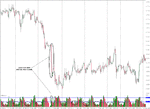Ok, I know there are no real volume figures for the FX market. However some platforms give volume figures anyway. I can only assume they are one of two things....
1: Figures for volume traded through that platform only.....
or
2: "Approximate" figures for the FX market
So my question is.........
Does anyone use these volume figures and if so are they reliable, do they add anything to your analysis?
Cheers,
PKFFW
1: Figures for volume traded through that platform only.....
or
2: "Approximate" figures for the FX market
So my question is.........
Does anyone use these volume figures and if so are they reliable, do they add anything to your analysis?
Cheers,
PKFFW

